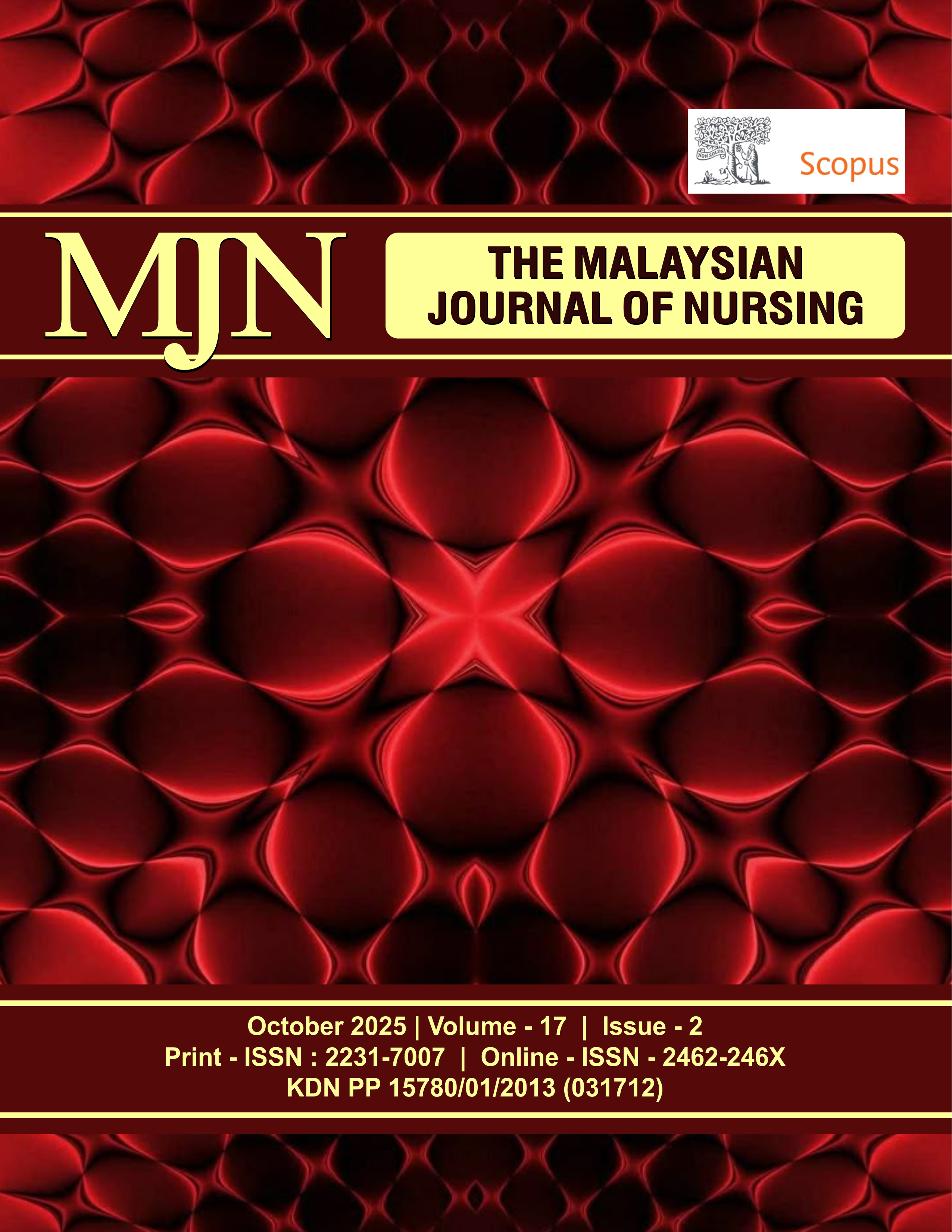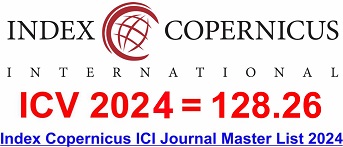Effectiveness of Play-Based Nursing Interventions on Hand Function in Children with Cerebral Palsy: A Quasi-Experimental Study
DOI:
https://doi.org/10.31674/mjn.2025.v17i02.015Abstract
Background: Traditional nursing interventions for children with Cerebral Palsy (CP) often lack active engagement and show limited improvement in motor function. Play interventions involving manipulative activities may better support motor skill development. Objectives: To evaluate the effect of structured play-based nursing interventions on hand motor skills in children with cerebral palsy. Methods: A quasi-experimental pre-test/post-test design with a control group was used. The study was conducted at the Paediatric Welfare Hospital in Baghdad from November 25, 2024, to February 13, 2025. A non-probability sample of 79 children was identified based on the study criteria; of these, 64 children met the eligibility criteria and agreed to participate. While all children continued routine care, only intervention groups received play-based therapy using clay, beads, and sand. The Box and Block Test (BBT) was used to assess hand function before and after the intervention. Data were analysed using SPSS (version 0.27) with descriptive and inferential statistics. Results: The intervention groups demonstrated significant improvements in hand function compared to the control group (ANOVA: F = 8.11, p = 0.001, η² = 0.29), reflecting a medium-to-large effect size. Analysis across time points showed that at post-test 1, the effect size was medium (η² = 0.17), whereas at post-test 2, it increased to medium-to-large (η² = 0.29). Post-hoc comparisons indicated that the clay intervention produced the largest gains in Box and Block Test scores (Cohen’s d = 0.65, medium effect), while sand therapy resulted in moderate improvements and bead therapy showed smaller gains. Overall, the percentage improvement in hand function ranged from 18% to 27% across intervention groups. Conclusion: Nursing interventions incorporating play activities are effective in improving hand function in children with cerebral palsy. These methods are child-friendly, supporting the development of motor skills and promoting greater independence. However, no follow-up assessments were conducted to evaluate the long-term sustainability of improvements. Future studies should include follow-up evaluations to confirm lasting benefits.
Keywords:
Cerebral Palsy, Hand Function, Nursing Programme, Play TherapyDownloads
References
Abdi, F., Karamoozian, A., Lotfilou, M., Gholami, F., Shaterian, N., Niasar, A. A., Aghapour, E., & Jandaghian-Bidgoli, M. (2025). Effect of play therapy and storytelling on the anxiety level of hospitalized children: A randomized controlled trial. BMC Complementary Medicine and Therapies, 25(1), 23. https://doi.org/10.1186/s12906-025-04767-4
Abdulzahra, F. A., & Shawq, A. H. (2024). Mobile application to develop nurses’ knowledge of pediatric cardiopulmonary resuscitation: A quasi-experimental study. Journal of Emergency Medicine, Trauma and Acute Care, 2024(6). https://doi.org/10.5339/jemtac.2024.absc.7
Alaee, N., Shahboulaghi, F. M., Khankeh, H., & Kermanshahi, M. K. S. (2015). Psychosocial challenges for parents of children with cerebral palsy: A qualitative study. Journal of Child and Family Studies, 24(7), 2147–2154. https://doi.org/10.1007/s10826-014-0016-3
Allen, M. S., Robson, D. A., & Iliescu, D. (2023). Face validity: A critical but ignored component of scale construction in psychological assessment. European Journal of Psychological Assessment, 39(3), 153–156. https://doi.org/10.1027/1015-5759/a000777
Al-Mosawi, A. J. (2019). The pattern of cerebral palsy in Iraqi children. MedLife Clinics, 1(1), 1001, 1–9. https://www.medtextpublications.com/open-access/the-pattern-of-cerebral-palsy-in-iraqi-children-212.pdf
Anjum, S., Huma, R., Basista, R., Jena, M., Parveen, H., & Naaz, N. (2024). Current trends in cerebral palsy rehabilitation. Futuristic Trends in Medical Sciences, 3, 227–238. https://doi.org/10.58532/v3bbms18p2ch8
Arslan, T. F., & Akkoyun, S. (2022). Nursing care of a cerebral palsy child patient according to Orem’s self-care deficit nursing theory: a case report. Journal of Education and Research in Nursing, 19(3), 371–376. https://doi.org/10.5152/jern.2022.32548
Azeez A, Hussain A, & Shawq A. (2023). Effectiveness of an educational program on nannies' practice regarding Cholera Infection in the Nurseries. Health Educ Health Promot, 11 (3), 349-356. http://hehp2.modares.ac.ir/article-5-65254-en.html
Basit, A., Qureshi, M. S., & Arif, M. I. (2022). Fostering fine motor skills of children with cerebral palsy: Exercises & therapies. Webology, 19(2), 565. https://www.researchgate.net/publication/358978860_ .
Blank, R., Smits-Engelsman, B., Polatajko, H., & Wilson, P. (2019). European Academy for Childhood Disability (EACD): Recommendations on the definition, diagnosis, and intervention of developmental coordination disorder (DCD). Developmental Medicine & Child Neurology, 61(3), 242–285. https://doi.org/10.1111/dmcn.14132
Cameron, K. L., Albesher, R. A., McGinley, J. L., Allison, K., Cheong, J. L. Y., & Spittle, A. J. (2020). Movement-based interventions for preschool-age children with, or at risk of, motor impairment: A systematic review. Developmental Medicine & Child Neurology, 62(3), 290–296. https://doi.org/10.1111/dmcn.14394
Chounti, A., Hägglund, G., Wagner, P., & Westbom, L. (2013). Sex differences in cerebral palsy incidence and functional ability: A total population study. Acta Paediatrica, 102(7), 712–717. https://doi.org/10.1111/apa.12240
Desrosiers, J., Bravo, G., Hébert, R., Dutil, E., & Mercier, L. (1994). Validation of the Box and Block Test as a measure of dexterity of elderly people: Reliability, validity, and norms studies. Archives of Physical Medicine and Rehabilitation, 75(7), 751-755. https://doi.org/10.1016/0003-9993(94)90130-9
Eidan, T. A. Shawq, A. H. (2024). Effect of a nutritional education program on mother knowledge regarding their children nutritional status. Journal of Obstetrics, Gynecology and Cancer Research, 9(5), 522-531. https://doi.org/10.30699/jogcr.9.5.522 https://doi.org/10.30699/jogcr.9.5.522
El-samad, A. A. A., El-Meniawy, G. H., El-Din, N. S. M., & Mohamed, N. E. (2021). Pinch grip strength and fine manual control in children with diplegic cerebral palsy: A cross-sectional study. Bulletin of Faculty of Physical Therapy, 26(1). https://doi.org/10.1186/s43161-021-00048-6
Faccioli, S., Pagliano, E., Ferrari, A., Maghini, C., Siani, M. F., Sgherri, G., Cappetta, G., Borelli, G., Farella, G. M., Foscan, M., Viganò, M., Sassi, S., Perazza, S., Sghedoni, S., & Borelli, G. (2023). Evidence-based management and motor rehabilitation of cerebral palsy children and adolescents: A systematic review. Frontiers in Neurology, 14, 1171224. https://doi.org/10.3389/fneur.2023.1171224
Harini, K., Raj, G., & Dhasaradharaman, K. (2022). A comparative study of play therapy and child-friendly constraint induced movement therapy in cerebral palsy. International Journal of Health Sciences and Research, 12(7), 48–50. https://doi.org/10.52403/ijhsr.20220706
Hasan, S., Shaker, N., & Ismail, Z. (2015). Impact of spastic cerebral palsy upon the quality of life of children under the age of 12 years in Erbil City: Parents’ reports. Iraqi National Journal of Nursing Specialties, 28(1), 8–16. https://doi.org/10.58897/injns.v28i1.214
Hervo, J. (2025). Virtual reality-based fine motor skills training in paediatric rehabilitation: A scoping review. BMJ Open, 15(1), e090862. https://doi.org/10.1136/bmjopen-2022-090862.
Hestbaek, L., Vach, W., Andersen, S. T., & Lauridsen, H. H. (2021). The effect of a structured intervention to improve motor skills in preschool children: Results of a randomized controlled trial nested in a cohort study of Danish preschool children, the MIPS study. International Journal of Environmental Research and Public Health, 18(23), 12272. https://doi.org/10.3390/ijerph182312272
Hines, A., Bundy, A. C., Black, D., Haertsch, M., & Wallen, M. (2019). Upper limb function of children with unilateral cerebral palsy after a magic-themed HABIT: A pre-post study with 3- and 6-month follow-up. Physical & Occupational Therapy in Pediatrics, 39(4), 404–419. https://doi.org/10.1080/01942638.2018.1505802
Jongbloed-Pereboom, M., Nijhuis-Van der Sanden, M. W. G., & Steenbergen, B. (2013). Norm scores of the box and block test for children ages 3–10 years. American Journal of Occupational Therapy, 67(3), 312–318. https://doi.org/10.5014/ajot.2013.006643
Kalel, J. M., & Shawq, A. H. (2024). Effect of music medicine intervention on child’s pain level during bone marrow aspiration and lumbar puncture procedures. Iraqi National Journal of Nursing Specialties, 1(37), 103–111. https://doi.org/10.58897/99mxqa51
Konukbay, D., Vural, M., & Yildiz, D. (2024). Parental stress and nurse-parent support in the neonatal intensive care unit: A cross-sectional study. BMC Nursing, 23(1), 820. https://doi.org/10.1186/s12912-024-02458-y
Maciejewski, M. L. (2020). Quasi-experimental design. Biostatistics & Epidemiology, 4(1), 38–47. https://doi.org/10.1080/24709360.2018.1477468
Maharani, N., & Jannah, M. (2018). The effect of constructive play with clay media towards fine motor skill of children. International Journal of Advanced Research, 6(3), 87–94. https://doi.org/10.21474/ijar01/6653
Mathiowetz, V., Volland, G., Kashman, N., & Weber, K. (1985). Adult norms for the Box and Block Test of manual dexterity. American Journal of Occupational Therapy, 39(6), 386–391. https://doi.org/10.5014/ajot.39.6.386
Maurer, M. N., & Roebers, C. M. (2020). Is the fine motor-executive functions link stronger for new compared to repeated fine motor tasks? PLoS One, 15(11), e0241308. https://doi.org/10.1371/journal.pone.0241308
McIntyre, S., Goldsmith, S., Webb, A., Ehlinger, V., Hollung, S. J., McConnell, K., Arnaud, C., Smithers-Sheedy, H., Oskoui, M., Khandaker, G., & Himmelmann, K. (2022). Global prevalence of cerebral palsy: A systematic analysis. Developmental Medicine & Child Neurology, 64(12), 1494–1506. https://doi.org/10.1111/dmcn.15346
Moraga-Amaro, R., Moreno, O., Llop, J., Bankstahl, M., & Bankstahl, J. P. (2025). Short- and long-term changes in neurological, behavioural, and blood biomarkers following repeated mild traumatic brain injury in rats—Potential biological sex-dependent effects. Frontiers in Molecular Neuroscience, 18, 1–15. https://doi.org/10.3389/fnmol.2025.1488261
Musihb, Z. S., Hussein, H. S. A., & Ali, A. M. A. (2024). Disruption of sleep patterns among secondary school adolescents. Journal of Integrative Nursing, 6(3), 145–149. https://doi.org/10.4103/jin.jin_63_24
Novak, I., Morgan, C., Adde, L., Blackman, J., Boyd, R. N., Brunstrom-Hernandez, J., Cioni, G., Damiano, D., Darrah, J., Eliasson, A. C., De Vries, L. S., Einspieler, C., Fahey, M., Fehlings, D., Ferriero, D. M., Fetters, L., Fiori, S., Forssberg, H., Gordon, A. M., … Badawi, N. (2017). Early, accurate diagnosis and early intervention in cerebral palsy: Advances in diagnosis and treatment. JAMA Pediatrics, 171(9), 897–907. https://doi.org/10.1001/jamapediatrics.2017.1689
Novak, I., Paton, M. C. B., Finch-Edmondson, M., Badawi, N., Velde, A., Hines, A., Dark, L., Khamis, A., Namara, M. M., Stanton, E., & Morgan, C. (2021). Commentary and clinical implications of “State of the evidence traffic lights 2019: Systematic review of interventions for preventing and treating children with cerebral palsy”. Journal of Experimental Neurology, 2(3), 112–119. https://doi.org/10.33696/neurol.2.043
Peripheral, P., Al-fahham, T. M., & Al-jubouri, M. S. N. M. B. (2024). Effectiveness of foot massage and range of motion exercise on diabetic. Iraqi National Journal of Nursing Specialties, 1(37), 50–64. https://doi.org/10.58897/b1smxb95
Philip, S. S., Guzzetta, A., Chorna, O., Gole, G., & Boyd, R. N. (2020). Relationship between brain structure and cerebral visual impairment in children with cerebral palsy: A systematic review. Research in Developmental Disabilities, 99, 103580. https://doi.org/10.1016/j.ridd.2020.103580
Pragistha, I. F., Mansur, H., & Triningsih, R. W. (2022). The effect of the use of kinetic sand as a stimulation media for fine motor development in preschool children at RA Al-Masithoh Karangploso. Journal of Local Therapy, 1(1), 18-23. https://doi.org/10.31290/jlt.v1i1.2939
Prochaska, E., & Ammenwerth, E. (2024). Clinical utility and usability of the digital Box and Block Test: Mixed methods study. JMIR Rehabilitation and Assistive Technologies, 11, e54939. https://doi.org/10.2196/54939
Qasim, A. (2022). Quality of life of children aged 8– less than 13 years with acute lymphocytic leukemia undergoing chemotherapy at hematology center in medical city. Iraqi National Journal of Nursing Specialties, 35(1), 1–10. https://doi.org/10.58897/injns.v35i1.504
Rahman, S. A. A., Elsaied, S., Elshamy, M., Mohamed, S., & El-Dien, N. (2022). Effectiveness of play therapy on gross manual dexterity in children with hemiparetic cerebral palsy. International Journal of Recent Advances in Multidisciplinary Research, 6(2), 4637-4641. https://www.researchgate.net/publication/362367205
Rajani, R. (2023). Increase ability motorcycle fine through kinetic sand. Jurnal Asesmen dan Intervensi Anak Berkebutuhan Khusus, 22(2), 111–115. https://doi.org/10.17509/jassi.v22i2.67897 .
Romeo, D. M., Sini, F., Brogna, C., Albamonte, E., Ricci, D., & Mercuri, E. (2016). Sex differences in cerebral palsy on neuromotor outcome: A critical review. Developmental Medicine & Child Neurology, 58(8), 809–813. https://doi.org/10.1111/dmcn.13137
Shawq, A. H., (2024). Effectiveness of deep breathing technique on pain level of school children during catheterization. Medical Journal of Babylon, 21(Suppl 1), 120-125. http://dx.doi.org/10.4103/mjbl.mjbl_258_23
Sheikhzakaryaee, N., Nemati, S. M., & Valiee, S. (2024). Explaining the nurses’ experiences of caring for children with cerebral palsy: a qualitative study [Preprint]. Research Square.1–15. http://dx.doi.org/10.21203/rs.3.rs-5197864/v1
Şimşek, T. T., & Tuç, G. (2014). Examination of the relation between body mass index, functional level and health-related quality of life in children with cerebral palsy. Turkish Archives of Pediatrics, 49(2), 130–137. https://doi.org/10.5152/tpa.2014.1238
Sulemi, S., Dratis R. V., & Mujiatiningsih, M. (2023). Improving children’s fine motor skills through meronce activities in kindergarten. TEMATIK: Jurnal Pemikiran dan Penelitian Pendidikan Anak Usia Dini, 8(2), 111-119. https://doi.org/10.26858/tematik.v8i2.27569
Sundresh, N. J. (2017). Effectiveness of clay modeling in improving the hand motor skills among mild mentally retarded children. Global Journal for Research Analysis, 6(4), 536–537. https://www.worldwidejournals.com/global-journal-for-research-analysis-GJRA/recent_issues_pdf/2017/April/April_2017_1492167279__111.pdf .
Woodgate, R. L., Gonzalez, M., Ripat, J. D., Edwards, M., & Rempel, G. (2024). Exploring fathers’ experiences of caring for a child with complex care needs through ethnography and arts-based methodologies. BMC Pediatrics, 24(1), 1–17, 93. https://doi.org/10.1186/s12887-024-04567-8
Wray, J., Russell, J., Gibson, F., Kenten, C., & Oulton, K. (2025). The forgotten voices: Enabling children and young people with intellectual disability to express their views on their inpatient hospital experience. Health Expectations, 28(1), e70168. https://doi.org/10.1111/hex.70168
Yogman, M., Garner, A., Hutchinson, J., Hirsh-Pasek, K., Golinkoff, R. M., Baum, R., Gambon, T., Lavin, A., Mattson, G., & Wissow, L. (2018). The power of play: A pediatric role in enhancing development in young children. Pediatrics, 142(3), e20182058. https://doi.org/10.1542/peds.2018-2058
Published
How to Cite
Issue
Section
License
Copyright (c) 2025 The Malaysian Journal of Nursing (MJN)

This work is licensed under a Creative Commons Attribution-NonCommercial-NoDerivatives 4.0 International License.



































